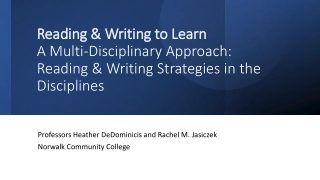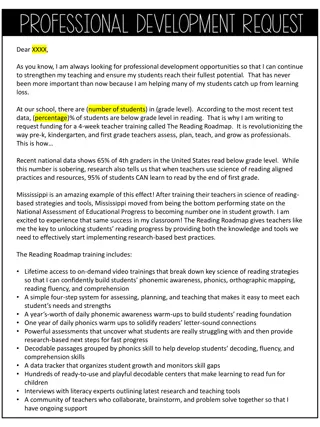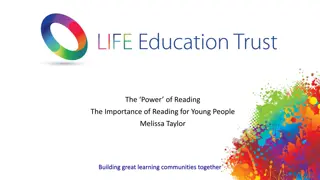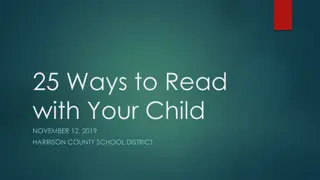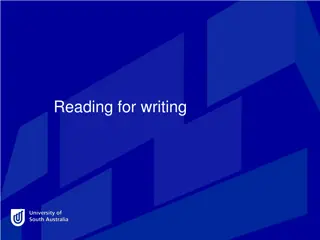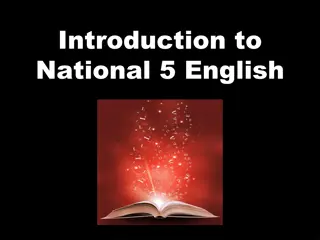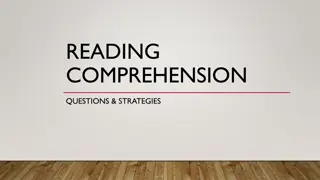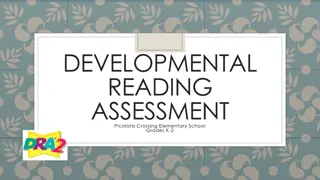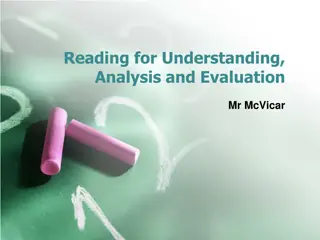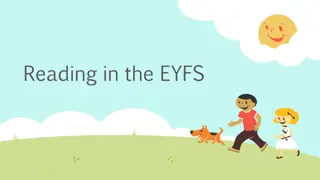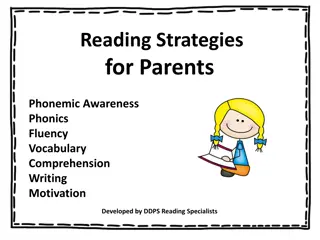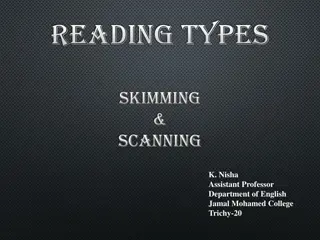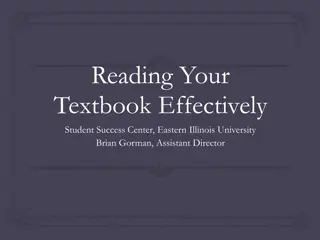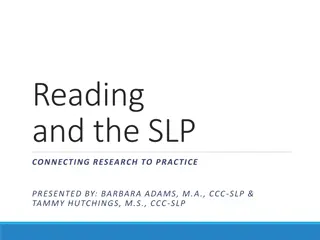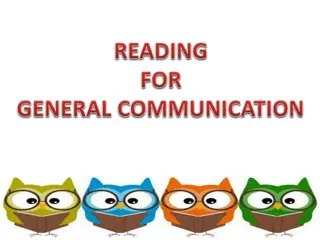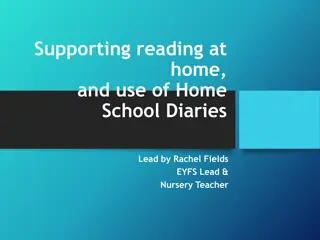Unlocking Critical Reading Skills: Strategies and Techniques
Enhance your reading comprehension through critical reading practices. Understand the definition of critical reading, its importance in the reading process, and learn practical steps to become a critical reader. Discover how critical reading fits into the C.A.R.E. model and the benefits it brings to understanding texts effectively.
Download Presentation

Please find below an Image/Link to download the presentation.
The content on the website is provided AS IS for your information and personal use only. It may not be sold, licensed, or shared on other websites without obtaining consent from the author. Download presentation by click this link. If you encounter any issues during the download, it is possible that the publisher has removed the file from their server.
E N D
Presentation Transcript
Critical Reading Critical Reading How to take your reading to the next level . Critical Reading Steps Modified from: Salisbury University: 7 Critical Reading Strategies
What does Critical Reading mean? What does Critical Reading mean? On a sheet of notebook paper, take one minute to try to write down a definition for Critical Reading. Now, turn to a partner and pair-share your definitions. What do you think? Share as a class what you think Critical Reading means.
CRITICAL READING: CRITICAL READING: Definition: Critical Reading is the opposite of careless reading. Critical Reading means to read carefully, thoughtfully, and with a purposein order to better understand and evaluate a text.
Are you a Critical Reader? Are you a Critical Reader? How do you usually read a text? Do you take notes? Skim? Read quickly? Turn to the person next to you and share your current reading process.
Where does Critical Where does Critical Reading fit in our Reading fit in our C.A.R.E. C.A.R.E. Model? Model?
Yup. Yup. Comprehension. Comprehension. Reading Critically helps us Reading Critically helps us to better understand or to better understand or comprehend comprehend, the text. , the text. It also prepares us for the It also prepares us for the next steps of the C.A.R.E. next steps of the C.A.R.E. Learning Model Learning Model. .
4 Steps to Becoming a Critical Reader 1) Preview: Skim before you read 2) Contextualize: Where does it fit? 3) Ask Questions to Understand and Remember 4) Identify the Main Ideas and Restate them in your Own Words
1) PREVIEW: Learning about a text before you read it What can you learn about the text before you ever read it? Take a look at titles, headings, bolded words, and pictures.
TRY IT In pairs, practice previewing today s reading. What did you find?
Read through the passage for Read through the passage for the 1st time the 1st time Remember, when reading critically, you ll usually want to read through a passage more than once. Read the first time through just to get a sense of the overall content and shape of the passage. Do not take notes. Today we will read completely through this passage fully two times.
2) CONTEXTUALIZE: Placing a text in its historical, cultural, and biographical context When you read a text, you read it through the lens of your own experience. Your understanding of the words on the page and their significance is informed by what you have come to know and value from living in a particular time and place. But the texts you read were all written in the past, sometimes in a radically different time and place.
2) CONTEXTUALIZE: Placing a text in its historical, cultural, and biographical context 1) Ask yourself: When do the events in the the reading take place? Where do the events in the reading take place? How might the people I m reading about have similar or different experiences than my own? 2) 3)
TRY IT In pairs, practice Contextualizingtoday s reading. When do the events in the reading take place? Where do the events in the reading take place? How might the people I m reading about have similar or different experiences than my own? 1) 2) 3)
3) QUESTIONING: Asking questions to understand and remember As students, you are used to teachers asking you questions about your reading. These questions are designed to help you understand a reading and respond to it more fully. When you need to understand and use new information though it is most beneficial if you write the questions, as you read the text.
3) QUESTIONING: Asking questions to understand and remember With this strategy, you can write questions any time, but in difficult academic readings, you will understand the material better and remember it longer if you write a question for every paragraph or brief section. Each question should focus on a main idea, not on illustrations or details, and each should be expressed in your own words, not just copied from parts of the paragraph.
TRY IT Read through the passage a 2nd time. In pairs, practice Questioningtoday s reading. What questions do you have about the reading? After each section, write a question.
4) IDENTIFYING MAIN IDEAS: Identifying the main ideas and then restating them in your own words Outlining and summarizing are especially helpful strategies for understanding the content and structure of a reading selection. Outlining reveals the basic structure of the text Summarizing restates a selection's main argument in brief, often in paragraph format The key to both outlining and summarizing is being able to distinguish between the main ideas and the supporting ideas and examples. The main ideas form the backbone, the strand that holds the various parts and pieces of the text together. Outlining the main ideas helps you to discover this structure.
TRY IT In pairs, practice Identifying Main Ideas from today s reading by outlining it. Look at the text a 3rd time. Go back through the reading, and write a one sentence summary of the main idea of each section. (Note: Do NOT include your opinion in this step)
Sowhats the reading about? After you ve worked with your partner to write an outline of the article s main ideas, take your notes with you and SWITCH PARTNERS.
Sowhats the reading about? Now the test. Pretend that you are in an elevator with your new partner. You ve just read a really interesting article (the one we just read for class) and you want to tell them about it. The trick? You ve only got 30 seconds before the elevator ride is over .
Sowhats the reading about? In 30 seconds, tell your partner what the reading is about. Time is limited. Tell only the most important parts. Use your own words You may use your notes/outline to help you. Switch roles and let your partner try.
What do you think? Do you feel like you understand the reading better after this process? Pair-share
Why is Critical Reading Important? In your notebook, list as many reasons as you can think of concerning why critical reading is important. Pair-share
Now that youve Now that you ve Critically Read passage, you re ready to move on to the passage, you re ready to move on to the next steps of the C.A.R.E. Learning next steps of the C.A.R.E. Learning Model. Model. Critically Read the the Critically Reading Critically Reading a passage will give you a passage will give you the base to be able to the base to be able to Critically Think about about Critically Think and respond to it. and respond to it. The steps of Analyzing, Responding, and The steps of Analyzing, Responding, and Responding with Evidence in the C.A.R.E. Responding with Evidence in the C.A.R.E. model will ask you to employ these model will ask you to employ these critical thinking skills. critical thinking skills.
Wrap-UP What is one thing from today s passage or critical reading lesson that you will take away from today? Write it down in your notebook. Pair-share.


